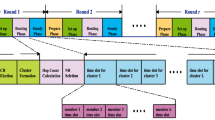Abstract
Previous studies on wireless sensor networks indicate one of the most important research topics is to consider both significance of the reduction in sensor nodes energy consumption and improving network lifetime. Regarding results of some researchers using sinks, mobility has a substantial impact on the performance of sensor networks concerning reducing total energy consumption, increasing the number of active nodes and solving the energy-hole problem. In this study, we consider hexagons beehives feature where sensor nodes are distributed across a hexagon randomly. This hexagonal is divided into equal clusters based on the radius of hexagonal. Also, the need for cluster heads to be close to their centre of clusters in the previous similar model is solved by adding mobility to the sinks, providing a pre-determined path for mobile sinks and covering each cluster by sinks from two different directions. Therefore, the proposed model simulation results show the increase in the average of residual energy between sensor nodes, reducing total energy consumption, increasing the number of active nodes and ultimately improving the lifetime of wireless sensor networks related to previous models.










Similar content being viewed by others
References
Zhao, M., Yang, Y., & Wang, C. (2015). Mobile data gathering with load balanced clustering and dual data uploading in wireless sensor networks. IEEE Transactions on Mobile Computing,14(4), 770–785.
Guo, S., Wang, C., & Yang, Y. (2014). Joint mobile data gathering and energy provisioning in wireless rechargeable sensor networks. IEEE Transactions on Mobile Computing,13(12), 2836–2852.
Alsalih, W., Hassanein, H., & Akl, S. (2010). Placement of multiple mobile data collectors in wireless sensor networks. Ad Hoc Networks,8(4), 378–390.
Ma, M., Yang, Y., & Zhao, M. (2013). Tour planning for mobile data-gathering mechanisms in wireless sensor networks. IEEE Transactions on Vehicular Technology,62(4), 1472–1483.
Wang, J., et al. (2013). Mobility based energy efficient and multi-sink algorithms for consumer home networks. IEEE Transactions on Consumer Electronics,59(1), 77–84.
Sabor, N., et al. (2017). A comprehensive survey on hierarchical-based routing protocols for mobile wireless sensor networks: Review, taxonomy, and future directions. Wireless Communications and Mobile Computing. https://doi.org/10.1155/2017/2818542.
Kim, J.-W., et al. (2010). An intelligent agent-based routing structure for mobile sinks in WSNs. IEEE Transactions on Consumer Electronics,56(4), 2310–2316.
Lee, E., et al. (2010). Data gathering mechanism with local sink in geographic routing for wireless sensor networks. IEEE Transactions on Consumer Electronics,56(3), 1433–1441.
Güney, E., et al. (2010). Efficient integer programming formulations for optimum sink location and routing in heterogeneous wireless sensor networks. Computer Networks,54(11), 1805–1822.
Tian, K., et al. (2010). Data gathering protocols for wireless sensor networks with mobile sinks. In Global Telecommunications Conference GLOBECOM 2010 (pp. 1–6). Miami, FL: IEEE.
Wang, Z. M., et al. (2005). Exploiting sink mobility for maximizing sensor networks lifetime. In Proceedings of the 38th annual Hawaii international conference on system sciences (pp. 287a–287a). IEEE.
Papadimitriou, I., & Georgiadis, L. (2005). Maximum lifetime routing to mobile sink in wireless sensor networks. In Proceedings of the 13th IEEE SoftCOM.
Li, X., et al. (2012). Localized geographic routing to a mobile sink with guaranteed delivery in sensor networks. IEEE Journal on Selected Areas in Communications,30(9), 1719–1729.
Luo, J., & Hubaux, J.-P. (2010). Joint sink mobility and routing to maximize the lifetime of wireless sensor networks: The case of constrained mobility. IEEE/ACM Transactions on Networking (TON),18(3), 871–884.
Han, G., et al. (2016). A survey on mobile anchor node assisted localization in wireless sensor networks. IEEE Communications Surveys and Tutorials,18(3), 2220–2243.
Tashtarian, F., et al. (2015). On maximizing the lifetime of wireless sensor networks in event-driven applications with mobile sinks. IEEE Transactions on Vehicular Technology,64(7), 3177–3189.
Yue, Y., et al. (2016). Optimization-based artificial bee colony algorithm for data collection in large-scale mobile wireless sensor networks. Journal of Sensors, 7057490
Author information
Authors and Affiliations
Corresponding author
Additional information
Publisher's Note
Springer Nature remains neutral with regard to jurisdictional claims in published maps and institutional affiliations.
Rights and permissions
About this article
Cite this article
Amini, S.M., Karimi, A. & Shehnepoor, S.R. Improving Lifetime of Wireless Sensor Network Based on Sinks Mobility and Clustering Routing. Wireless Pers Commun 109, 2011–2024 (2019). https://doi.org/10.1007/s11277-019-06665-8
Published:
Issue Date:
DOI: https://doi.org/10.1007/s11277-019-06665-8




